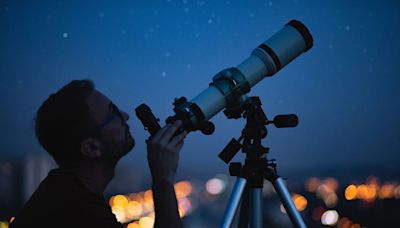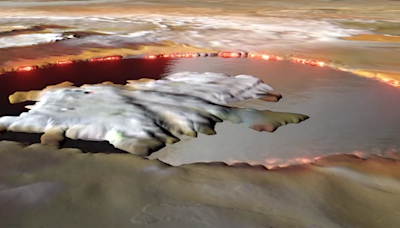Search results
Jupiter is the fifth planet from the Sun and the largest in the Solar System.It is a gas giant with a mass more than two and a half times that of all the other planets in the Solar System combined, and slightly less than one one-thousandth the mass of the Sun. Jupiter orbits the Sun at a distance of 5.20 AU (778.5 Gm) with an orbital period of 11.86 years.
- Jupiter (Mythology)
Jupiter (Latin: Iūpiter or Iuppiter, from Proto-Italic...
- Jupiter (Disambiguation)
Jupiter Amphitheatre, a valley in Victoria Land, Antarctica;...
- Rings of Jupiter
Discovery and structure. Jupiter's ring system was the third...
- Saturn
Saturn is the sixth planet from the Sun and the...
- Spheroid
The planet Jupiter is a slight oblate spheroid with a...
- Update
We would like to show you a description here but the site...
- File
You are free: to share – to copy, distribute and transmit...
- Super-Jupiter
A super-Jupiter is a gas giant exoplanet that is more...
- Great Red Spot
Close up view of the Great Red Spot by Juno. The Great Red...
- Jupiter (Mythology)
Apr 1, 2024 · Jupiter, the most massive planet of the solar system and the fifth in distance from the Sun. It is one of the brightest objects in the night sky; only the Moon, Venus, and sometimes Mars are more brilliant. Jupiter is designated by the symbol ♃. When ancient astronomers named the planet Jupiter for the Roman ruler of the gods and heavens ...
- What is the period of revolution of Jupiter?Jupiter takes nearly 12 Earth years to orbit the Sun, and it rotates once about every 10 hours, more than twice as fast as Earth.
- When was Jupiter's ring discovered?The existence of Jupiter's ring was first suggested in 1974, as a result of findings from the Pioneer 10 spacecraft as it approached the planet. Th...
- Is Jupiter the largest planet in the solar system?Jupiter is the most massive planet in the solar system. It has an equatorial diameter of about 143,000 km (88,900 miles).
- What is Jupiter made up of?Jupiter is composed primarily of hydrogen and helium. Under equilibrium conditions, the abundant chemically active elements are all expected to com...
- Name and Symbol
- Structure
- Formation
- Orbit
- Jupiter in The Solar System
- Research and Exploration
- Moons
- Related Pages
- Other Websites
Jupiter was named for the king of the gods. The Greeks called him Zeus. The Romans called him Jupiter. The symbol for Jupiter, ♃, is from the Greek zeta. It has a horizontal stroke ⟨Ƶ⟩. This stands as an abbreviation for Zeus.[page needed]
Jupiter is the biggest planet in the Solar System. Its diameter is 142,984 km. This is eleven times larger than the diameter of Earth. Jupiter is twice as massive as all the other planets in the Solar System put together. Jupiter is 318 times as massive as Earth. The volume of Jupiter is 1,317 times the volume of Earth. In other words, 1,317 Earth-...
Jupiter and other gas giants probably started as rocky planets, similar to Earth. This theory is called the core accretion model. The rocky core would have formed in the early Solar System, within a disk of gasesaround the Sun. When the planet reached a critical mass, its gravity started to quickly capture lots of gas. In this way, Jupiter became a...
The orbit of a planet is the time and path it takes to go around the Sun. In the time it takes for Jupiter to orbit the Sun once, the Earth orbits the Sun 11.86 times. One yearon Jupiter is equal to 11.86 years on Earth. The average distance between Jupiter and the Sun is 778 million kilometres. This is five times the distance between Earth and the...
Grand tack hypothesis
The orbit of Jupiter is unusual compared to planets in other star systems. It is usual for giant planets to be much nearer to their stars. Because Jupiter is not, this suggests an unusual explanation is needed for the arrangement of the planets in the Solar System. Astronomers have an idea on why this happened. It is called the grand tack hypothesis.[page needed] It is suggested that Jupiter formed about 3.5 astronomical units from the Sun. It started migrating inward and scattered the rocky...
Asteroids and comets
Jupiter's large gravity has had an effect on the Solar System. Jupiter protects the inner planets from cometsby pulling them towards itself. Because of this, Jupiter has the most comet impacts in the Solar System. Two groups of asteroids, called Trojan asteroids, have settled into Jupiter's orbit around the Sun. One group is called the Trojans and the other group is called the Greeks. They go around the Sun at the same time as Jupiter.
From Earth
Jupiter is the third brightest object in the night sky, after the Moon and Venus. The first person known to really study the planet was Galileo Galilei in 1610. He was the first person to see Jupiter's moons Io, Europa, Ganymede and Callisto. This was because he used a telescope, unlike anyone before him.[source?] No new moons were discovered for more than two hundred years. In 1892, astronomer E.E. Barnard found a new moon using his observatory in California. He called the moon Amalthea. It...
From spacecraft
Seven spacecrafts have flown past Jupiter since 1973. These were Pioneer 10 (1973), Pioneer 11 (1974), Voyagers 1 and 2 (1979), Ulysses (1992 and 2004), Cassini (2000) and New Horizons (2007). Two spacecraft have been brought into orbit around Jupiter. These were Galileo (1995) and Juno (2011).[source?] The Pioneer missions were the first spacecraft to take close-up pictures of Jupiter and its moons. Five years later, the two Voyager spacecraft discovered three new moons. They captured photo...
Jupiter has 95 known moons, as of February 23, 2023. The four largest were seen by Galileo with his primitive telescope and nine more can be seen with modern telescopes. Three moons were identified by the Voyager spacecraft. All other moons were first seen on Earth, using modern telescopes and advanced photography methods. The smallest moon (S/2003...
"Moons of Jupiter articles in Planetary Science Research Discoveries". Planetary Science Research Discoveries. Retrieved 2009-09-05.[permanent dead link]- 740.52 Gm (4.9501 AU)
- Jupiter
- 778.57 Gm (5.2044 AU)
Jupiter's swirling clouds, in a true-color image taken by the Hubble Space Telescope in April 2017 [1] The atmosphere of Jupiter is the largest planetary atmosphere in the Solar System. It is mostly made of molecular hydrogen and helium in roughly solar proportions; other chemical compounds are present only in small amounts and include methane ...
People also ask
Why is Jupiter called Jupiter?
Who is Jupiter in Roman mythology?
How big is Jupiter compared to Earth?
Why is Jupiter the biggest planet?
Learn about Jupiter, the largest and oldest planet in our solar system, with 95 moons and a powerful magnetic field. Find out how Jupiter's atmosphere, rings, and moons compare to Earth and other planets.
Learn about Jupiter, the largest and oldest planet in our solar system, with 95 moons and a powerful magnetic field. Find out how Jupiter's atmosphere, rings, and moons compare to Earth and other planets.
Learn about Jupiter's clouds, storms, moons, and magnetic field from this article by National Geographic. Find out how scientists have studied the gas giant with telescopes and spacecraft, and what mysteries remain.



